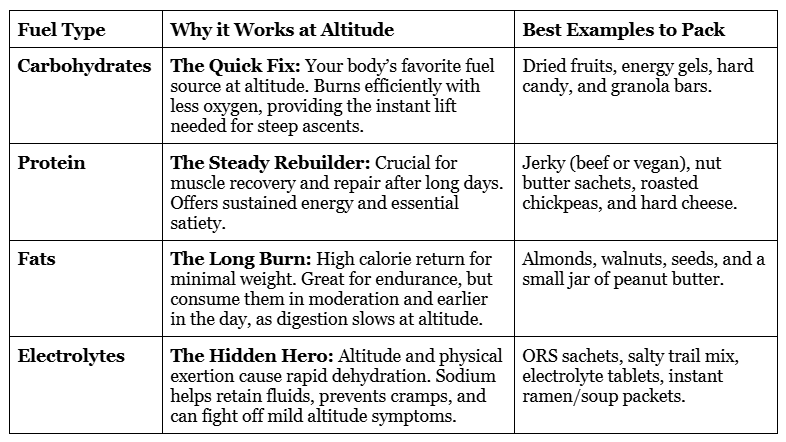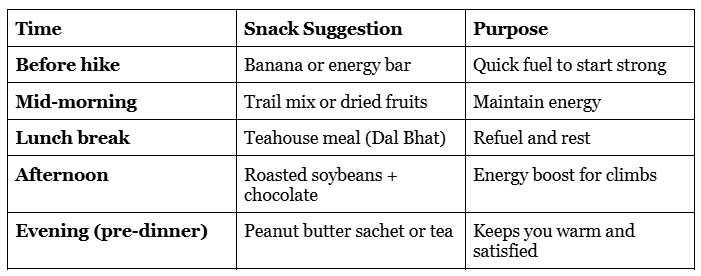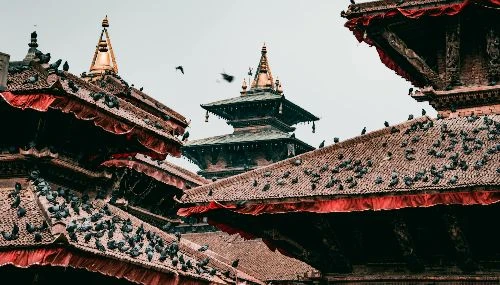When you’re deep in the Himalayas, every step feels like a victory. You’re weaving through rhododendron forests, crossing dizzying suspension bridges, and climbing toward passes lined with fluttering prayer flags. This is the magic of Nepal.
But let’s be real: behind every epic story is pure, strategic energy.
Trekking here isn’t a casual Sunday hike. It’s a relentless 6–8 hours a day, steep climbs that feel endless, and ever-changing weather—all while operating at altitudes where the air thins out and your body needs extra fuel just to function. While the teahouse meals (hello, satisfying Dal Bhat!) are essential, they can’t carry you between 10 AM and 4 PM.
That’s where your daypack snacks come in. They’re not just treats—they are your lifeline, your secret weapon against the fatigue and altitude whispers that try to slow you down.
Forget fussing over your down jacket for a moment. Smart snack planning is the unsung hero of a successful trek. A timely handful of trail mix or a blast of sugar can keep your pace steady, your legs moving, and your mood surprisingly cheerful, even when you’re pushing for that last ridge.
Think of snacks as your trail companions — small bursts of comfort that lift your spirits when fatigue sets in and the summit still feels far away.
Why Snacks Matter on a Trek
At high elevation, your body is essentially running an internal marathon every day. Oxygen levels drop, your heart rate increases, and your metabolism becomes turbo-charged, demanding more consistent calories just to keep you warm and moving.
Have you ever hit the "wall" mid-climb? That sudden dizziness, the lead in your legs? That’s your blood sugar crashing. Consistent, smart snacking is the simplest way to prevent those debilitating energy dives. It keeps your brain sharp, stabilizes your mood, and ensures you maintain stamina across those monumental hiking days.
Here’s the counterintuitive part: altitude often kills your appetite. You might not feel hungry, but you must eat. Having quick, appealing, non-heavy snacks ensures you meet your daily calorie goals.
And one final point, which is non-negotiable: hydration is fuel. If you’re dehydrated and low on electrolytes, your body can’t efficiently absorb the amazing nutrients from your snacks anyway. So, always pair food with water or a warm drink.
The Trekker’s Golden Rule:
👉 Eat often.
👉 Drink plenty.
👉 Snack smart.
What Makes a Good Trekking Snack?
Not every food is built for the rugged trail environment. Experienced trekkers know the tragedy of the melted chocolate bar, the exploded chip bag, and the heavy jar of peanut butter that can make a light backpack feel like a boulder.
Here’s the checklist for a truly "trek-ready" snack:
Lightweight & Compact: Every gram matters when you’re carrying it uphill for weeks. Aim for high calorie-per-ounce density.
Bomb-Proof Packaging: It must be non-perishable and immune to crushing, melting, or leaking.
High-Octane Calories: You’re likely burning between 3,000–5,000 calories a day. Your snacks need to pull their weight!
Minimalist Effort: Easy to pull out and eat during a two-minute break—no fuss, no refrigeration.
Balanced Fuel: The best strategy provides a mix of quick-release energy and long-term stamina.
Tip: For the sake of your tent-mates (and trail etiquette), avoid snacks in crinkly, loud packaging. It makes a big difference during quiet, pre-dawn starts.
The Science of Smart Snacking at Altitude
When you're hiking above 3,000 meters (10,000 ft), your body shifts its priorities. The lack of oxygen means your system favors simple fuels that burn efficiently.

Best Snacks to Pack for Trekking in Nepal
Here is a quick list of snacks that consistently perform well in the Himalayas:
Energy & Power Boosters
Custom Trail Mix: Mix nuts (almonds, cashews), seeds, and dried fruit (apricots, raisins). Customize it! You'll never get tired of it.
Dark Chocolate: Skip the milky bars—dark chocolate (70%+) offers antioxidants and is less likely to melt into a disaster. A true morale booster!
Nut Butter Sachets: Squeeze packs of peanut or almond butter are pure, instant, high-calorie energy with zero mess.
Quality Energy Bars: Stick to the brands you know won’t cause stomach trouble (RxBar, Clif, etc.).
Nepali Trailside Treasures (Buy Local!)
Encourage trekkers to save weight and support local shops. As you hike, look for these staples:
Chhurpi (Hard Yak Cheese): The iconic, rock-hard chew of the Himalayas. It lasts forever, provides dense protein, and keeps your mouth busy for hours.
Bhuja and Chiura: Spiced puffed rice (Bhuja) and beaten rice (Chiura). These lightweight, crunchy, carbohydrate-rich mixes are trail perfection.
Local Dried Fruits: Look for dried apples, apricots, or even Tibetan herbs sold in local markets in Kathmandu, Pokhara, or Namche Bazaar.
Comfort & Morale
These may seem indulgent, but after a 2,000-foot climb, they are necessary for the soul:
Personal Tea/Coffee Bags: A familiar instant coffee or your favorite herbal tea bag makes those chilly teahouse evenings feel like home.
Hard Candies: A quick sugar fix for when you're just dragging the last mile into the village.
Instant Soup/Ramen: Small packets of instant Miso or Chicken Ramen are fantastic for a salty, warm pick-me-up right before dinner.
They might not seem essential, but for a trekker, after a long climb, that square of chocolate or warm cup of tea feels like magic.
How to Pack and Store Your Snacks
A few tricks learned about logistics that make the whole experience smoother:
Portion Control: Before leaving the city, divide snacks into daily, reusable zip-lock or eco-pouches. This prevents overeating and makes finding fuel easy.
Easy Access: Keep your daily snack bag in a hip pocket or the top lid of your backpack. The goal is to eat every hour without breaking stride or removing your pack.
Leave No Trace (LNT): The mountains are sacred. Always pack out what you pack in. Carry a small empty pouch specifically for wrappers and waste.
The Altitude Price Tag: Stock up in Kathmandu or Pokhara. A chocolate bar that costs NPR 150 in the city might cost NPR 500 when reaching Gorakshep or other high-altitude spots. Budget accordingly.
A Safety Note: Stick to vegetarian meals and snacks above the higher towns (like Namche Bazaar), as meat refrigeration becomes unreliable.
Sample Daily Snack Plan
To help visualize your day on the trail:

Conclusion
The right snacks do more than just fill a gap—they are an act of self-care and preparation. They’re the little boost that allows you to fully engage with the majesty around you, rather than focusing on your aching legs or spinning head.
It might be a handful of roasted chickpeas shared with a guide, or that carefully saved piece of chocolate rewarded at the summit view. These small bites often become some of the best trail memories.
Pack smart, fuel well, and enjoy every single rewarding step through Nepal’s incredible mountains. You’ve earned the view.


.webp)

.webp)